warning lights OLDSMOBILE SILHOUETTE 1993 Owners Manual
[x] Cancel search | Manufacturer: OLDSMOBILE, Model Year: 1993, Model line: SILHOUETTE, Model: OLDSMOBILE SILHOUETTE 1993Pages: 323, PDF Size: 17.13 MB
Page 11 of 323
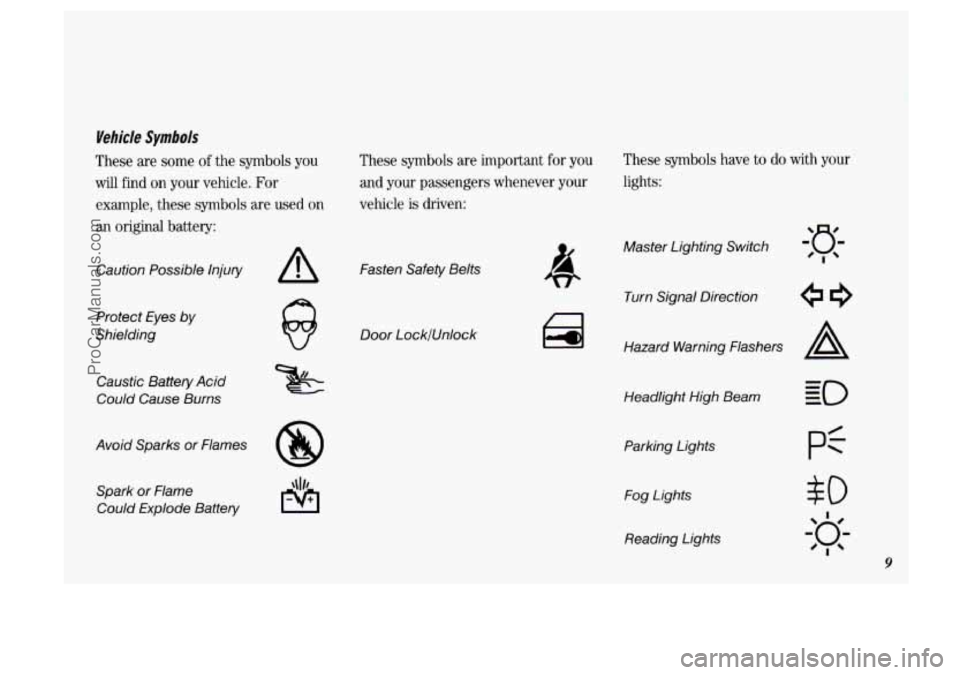
Vehicle Symbols
These are some of the symbols you
will find on your vehicle. For
example, these symbols are used
on
an original battery: These symbols
are important
for you
and your passengers whenever your
vehicle is driven:
Caution Possible Injury
Protect Eyes by
Shielding
Caustic Battery Acid
Could Cause Burns
Avoid Sparks or Flames Spark
or Flame
Could Explode Battery
A Fasten Safety Belts
Door LocklUnlock
These symbols have to do with your
lights:
Master Lighting Switch
Turn Signal Direction
Hazard Warning Flashers
A
Headlight High Beam
Parking Lights Fog Lights
Reading Lights
$0
I
20;-
'I
9
ProCarManuals.com
Page 12 of 323
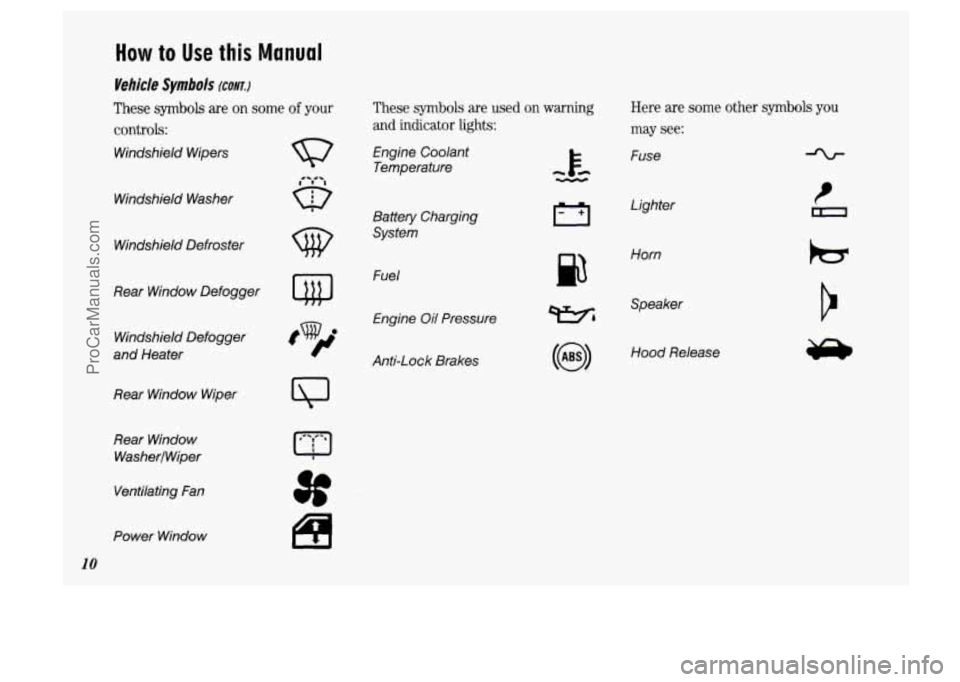
How to Use this Manual
Vehicle Symbols (CONT.)
These symbols are on some of your
controls:
Windshield Wipers
These symbols are used on warning Here are some other symbols you
and indicator lights: may see:
Engine Coolant
Temperature Fuse
Windshield Washer
Lighter
Battery Charging
System
w Windshield Defroster
p3
Horn
Fuel
Engine Oil Pressure
Rear Window
Defogger
Wh
Speaker
Windshield Defogger
and Heater Hood Release
Anti-Lock Brakes
Rear Window Wiper
Rear Window
WasherlWiper
Ventilating Fan
Power Window
10
ProCarManuals.com
Page 47 of 323
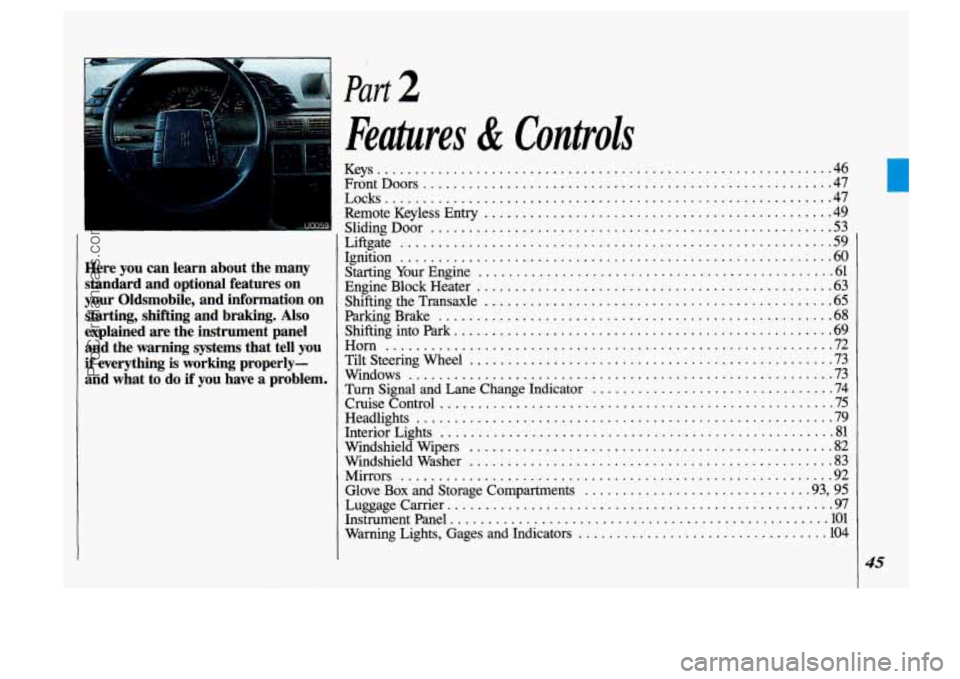
v..
.
Here you can learn about the many
standard and optional features on
your Oldsmobile. and information on starting. shifting and braking
. Also
explained are the instrument panel and the warning systems that tell you
if everything is working properly-
and what
to do if you have a problem .
Part 2
Features & Controls
Keys 46
FrontDoors
...................................................... 47
Remote Keyless Entry
.............................................. 49
Sliding Door 53
Liftgate
......................................................... 59
Ignition
......................................................... 60
Starting Your Engine
............................................... 61
Shifting the Transaxle
.............................................. 65
..........................................................
Locks ........................................................... 47
.....................................................
EngineBlockHeater ............................................... 63
ParkingBrake
.................................................... 68
Shiftingintopark
.................................................. 69
Horn ........................................................... 72
Windows
........................................................ 73
TiltSteeringWheel
................................................ 73
Turn Signal
and Lane Change Indicator ................................ 74
CruiseControl .................................................... 75
Headlights
....................................................... 79
Windshield Wipers
................................................ 82
Windshield Washer
................................................ 83
Mirrors
......................................................... 92
Glove
Box and Storage Compartments ............................. .93, 95
Luggagecarrier
....................................................
Instrument Panel .................................................. 101
Warning Lights, Gages and Indicators
................................. 104
InteriorLights
.................................................... 81
I'
45
L
ProCarManuals.com
Page 61 of 323
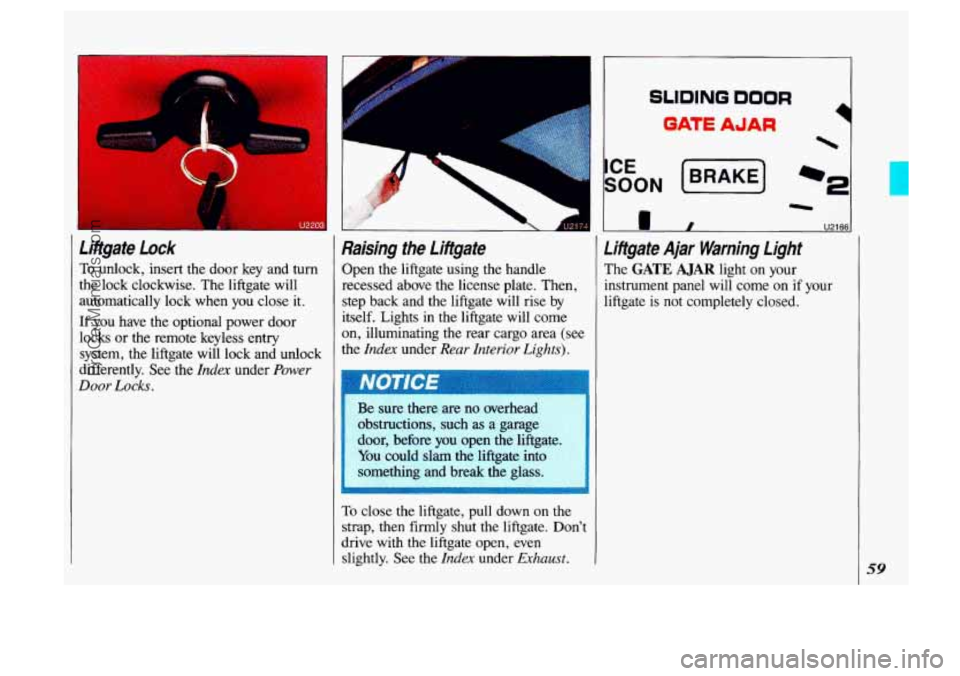
Litigate Lock
To unlock, insert the door key and turn
the lock clockwise. The liftgate will
automatically lock when you close it.
If you have the optional power door
locks or the remote keyless entry
system, the liftgate will lock and unlock
differently. See the
Index under Power
Door Locks.
F J217
Raising the Litigate
Open the liftgate using the handle
recessed above the license plate. Then,
step back and the liftgate will rise by
itself. Lights in the liftgate will come
on, illuminating the rear cargo area (set
the
Index under Rear Interior Lights).
Be sure thereare no overhead
obstructions,
such as a garage
door, before you open the liftgate.
You could slam the liftgate into
something and break the
glass.
To close the liftgate, pull down on the
strap, then firmly shut the liftgate. Don’t
drive with the liftgate open, even
slightly. See the
Index under Ejchaust.
SLIDING DOOR
QATE AJAR
sr
I U2166-
r
Litigate Ajar Warning Light
The GATE AJAR light on your
instrument panel will come on
if your
liftgate
is not completely closed.
59
ProCarManuals.com
Page 63 of 323
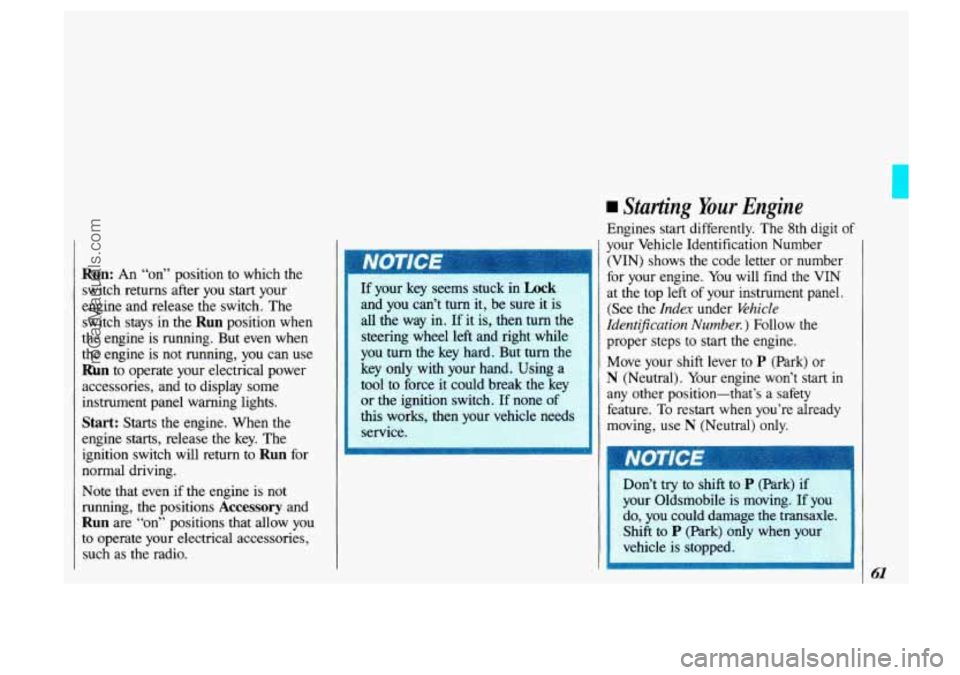
Run: An “on” position to which the
switch returns after you start your
engine and release the switch. The
switch stays in the
Run position when
the engine is running. But even when
the engine is not running, you can use
Run to operate your electrical power
accessories, and to display some
instrument panel warning lights.
Start: Starts the engine. When the
engine starts, release the key. The
ignition switch will return to
Run for
normal driving.
Note that even if the engine is not
running, the positions
Accessory and
Run are “on” positions that allow you
to operate your electrical accessories,
such as the radio.
I 1 and you can’t turn it, be sure it is
all the way
in. If it is, then turn the
steering wheel left and right while
you
turn the key hard. But turn the
: key only with your hand. Using a
-11 tool to force it could break the key
or the ignition switch. If none of
this works, then your vehicle needs
service.
Starting Your Engine
Engines start differently. The 8th digit of
your Vehicle Identification Number
(VIN) shows the code letter or number
for your engine. You will find the VIN
at the top left of your instrument panel.
(See the
Index under Vehicle
ZdentiJication
Number. ) Follow the
proper steps to start the engine.
I Move your shift lever to P (Park) or
N (Neutral). Your engine won’t start in
any other position-that’s a safety
feature.
To restart when you’re already
moving, use
N (Neutral) only.
I I
ProCarManuals.com
Page 82 of 323
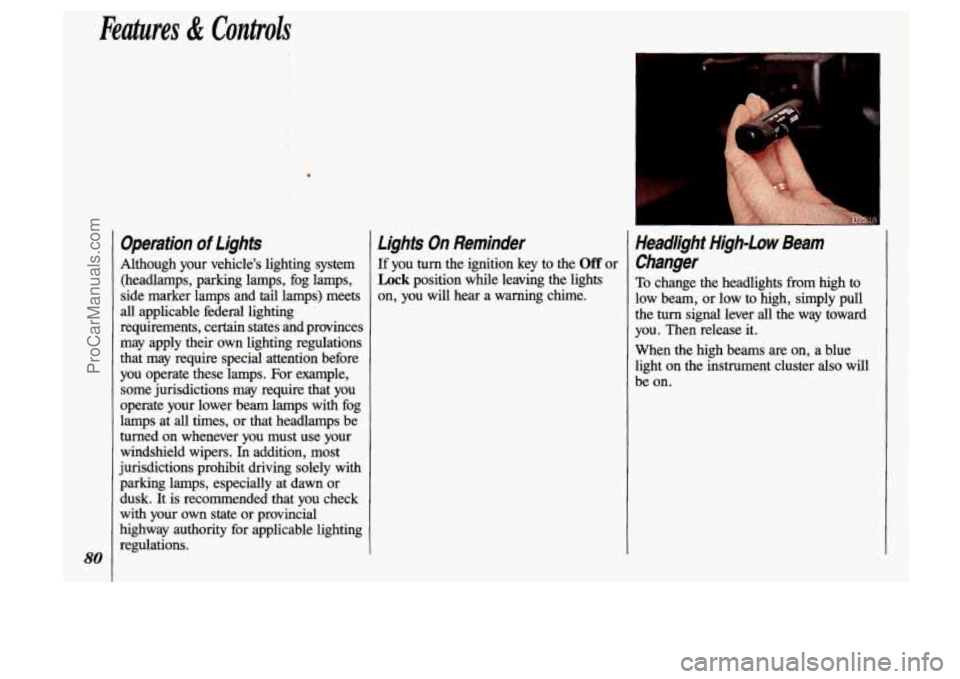
Features & Controls
80
Operation of Lights
Although your vehicle’s lighting system (headlamps, parking lamps, fog lamps,
side marker lamps and tail lamps) meets
all applicable federal lighting
requirements, certain states ahd provinces
may apply their own lighting regulations
that may require special attention before
you operate these lamps. For example,
some jurisdictions may require that you
operate your lower beam lamps with fog
lamps at all times, or that headlamps be
turned on whenever you must use your
windshield wipers. In addition, most
jurisdictions prohibit driving solely with parking lamps, especially at dawn or
dusk. It is recommended that you check
with your own state or provincial
highway authority for applicable lighting
regulations.
Lights On Reminder
If you turn the ignition key to the Off or
Lock position while leaving the lights
on, you will hear a warning chime.
I
Headlight High-Low Beam
Changer
To change the headlights from high to
low beam, or low to high, simply pull
the turn signal lever all the way toward
you. Then release it.
When the high beams are on, a blue
light on the instrument cluster also will
be on.
ProCarManuals.com
Page 103 of 323

The Instrument Panel- Your Information System
Your instrument panel is designed to let
you know at a glance how your vehicle
is running. You’ll know how fast you’re
going, how much fuel you’re using, and
many other things you’ll need to drive
safely and economically.
Refer to the accompanying diagram of
your instrument panel
to locate the
components listed below.
1. Side Vents
2. Light Controls
3. Turn SignaVHeadlight Beam Lever
4. Tilt Steering Wheel Lever
5. Instrument Cluster
6. Gearshift Lever
7. WiperIWasher Controls
8. Center Vents
9. Storage Compartment
10. Side Vents
11. Circuit Breaker/Relay Panel
12. Glove Box/Fuse Panel
13. Audio System
14. Rear Fan Controls
15. Cup HolderdAshtray
1 6. Locking Storage Bin
17. Lighter
18. Interior Lights Override Switch
19. Climate Controls
20. Ignition Switch
21. Hazard Warning Flashers Switch
22. Horn
23. Parking Brake Release
24. Hood Release
101
ProCarManuals.com
Page 104 of 323
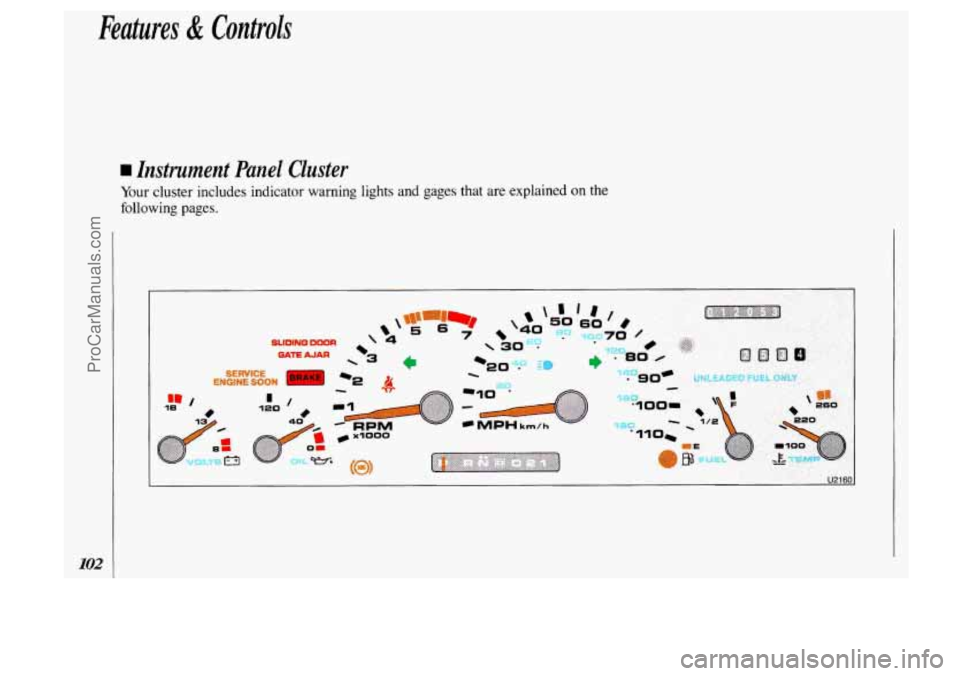
Features & Controls
4 Znstrument Panel Cluster
Your cluster includes indicator warning lights and gages that are ex\
plained on the
following pages.
102
mm 18
\3
-20'
ProCarManuals.com
Page 106 of 323
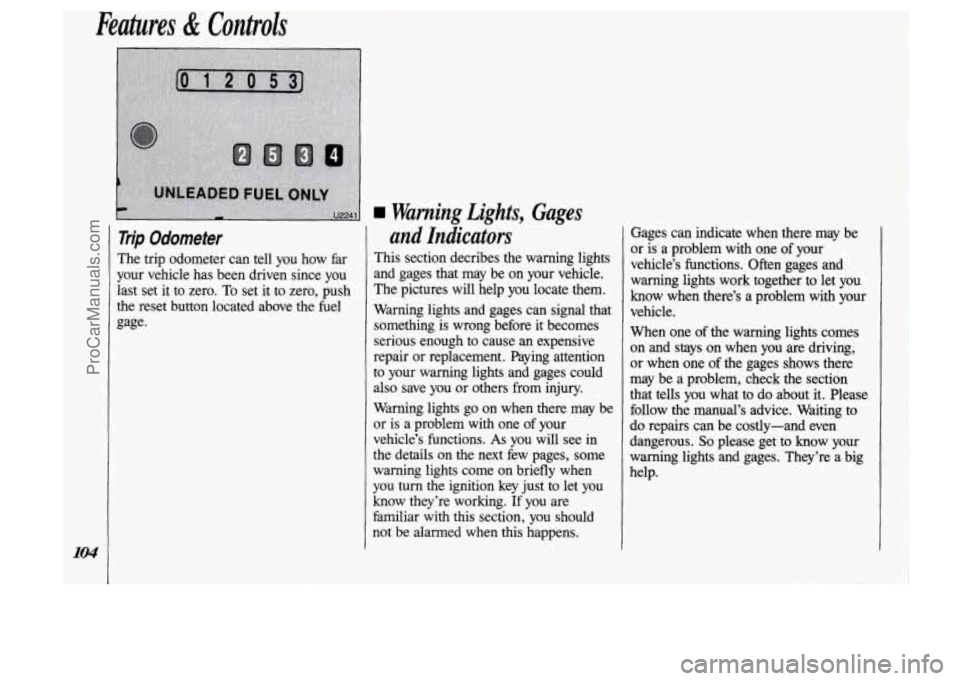
Features & Controls
Trip Odometer
The trip odometer can tell you how far
your vehicle has been driven since you
last set it to zero. To set it to zero, push
the reset button located above the fuel
gage.
and Indicators
This section decribes the warning lights
and gages that may be on your vehicle.
The pictures will help you locate them.
Warning lights and gages can signal that something is wrong before it becomes
serious enough to cause an expensive
repair or replacement. Paying attention
to your warning lights and gages could also save you or others from injury.
Warning lights go on when there may be
or is a problem with one
of your
vehicle’s functions.
As you will see in
the details on the next few pages, some warning lights come on briefly when
you turn the ignition key just to let you
know they’re working.
If you are
familiar with
this section, you should
not be alarmed when this happens. bages
can indicate when there may be
or is a problem with one of your
vehicle’s functions. Often gages and
warning lights work together to
let you
know when there’s a problem with your
vehicle.
When one of the warning lights comes
on and stays on when you are driving,
or when one
of the gages shows there
may be a problem, check the section
that tells you what to do about it. Please
follow the manual’s advice. Waiting to
do repairs can be costly-and even
dangerous.
So please get to know your
warning lights and gages. They’re a big
help.
ProCarManuals.com
Page 145 of 323
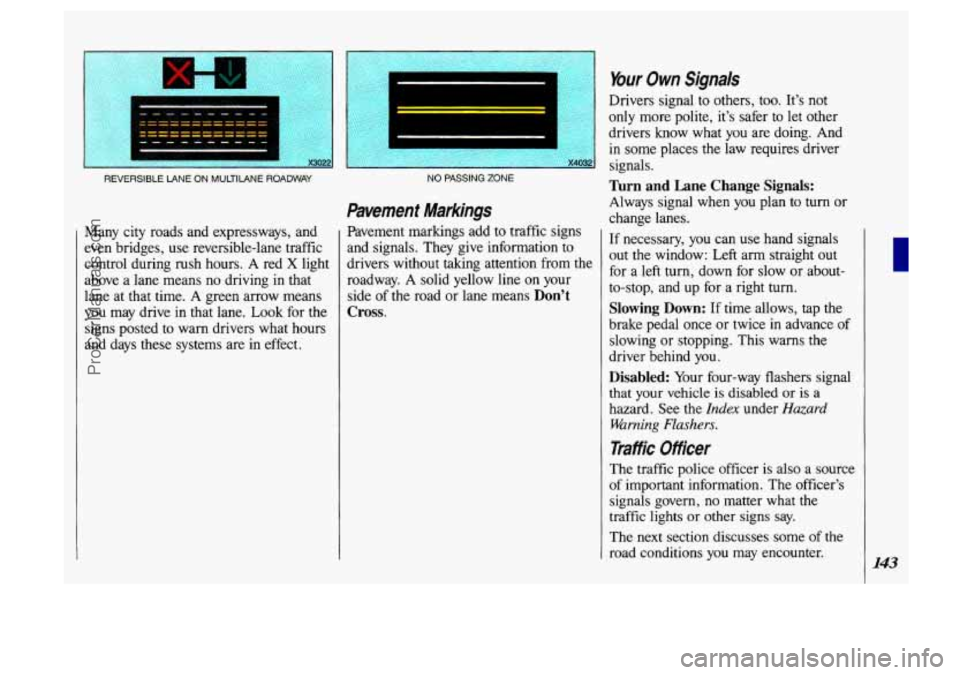
m%p&:*g%
REVERSIBLE LANE ON MULTILANE ROADWAY
Many city roads and expressways, and
even bridges, use reversible-lane traffic
control during rush hours.
A red X light
above a lane means no driving in that
lane at that time. A green arrow means
you may drive in that lane.
Look for the
signs posted to warn drivers what hours
and days these systems are in effect.
~ ~~~
NO PASSING ZONE
Pavement Markings
Pavement markings add to traffic signs
and signals. They give information to
drivers without taking attention from the
roadway.
A solid yellow line on your
side of the road or lane means
Don’t
Cross.
Your Own Signals
Drivers signal to others, too. It’s not
only more polite, it’s safer
to let other
drivers know what
you are doing. And
in some places the law requires driver
signals.
Turn and Lane Change Signals:
Always signal when you plan to turn or
change lanes.
If necessary, you can use hand signals
out the window: Left arm straight out
for a left turn, down for slow or about-
to-stop, and up for a right turn.
Slowing Down: If time allows, tap the
brake pedal once or twice in advance of
slowing or stopping. This warns the
driver behind you.
Disabled: Your four-way flashers signal
that your vehicle is disabled or
is a
hazard. See the
Index under Hazard
Warning Flashers.
Traffic Officer
The traffic police officer is also a source
of important information. The officer’s
signals govern, no matter what the
traffic lights
or other signs say.
The next section discusses some
of the
road conditions you may encounter.
143
ProCarManuals.com